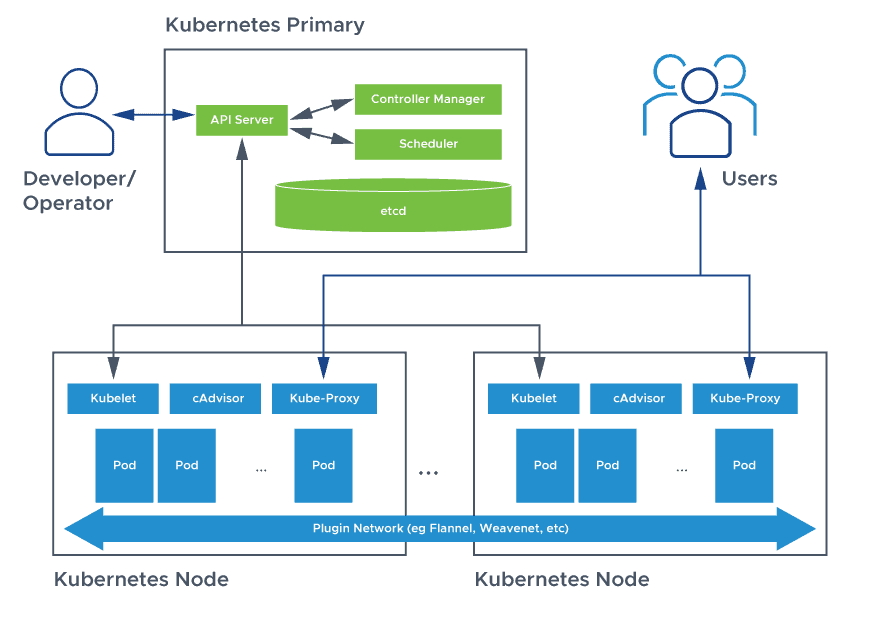Table of contents
- 1. What is Kubernetes?
- 2. What are the benefits of using k8s?
- 3. Explain the architecture of Kubernetes.
- 4. What is Control Plane?
- 5. Write the difference between kubectl and kubelets.
- 6. Explain the role of the API server.
- I'm confident that this article will prove to be valuable, helping you discover new insights and learn something enriching .
In the realm of modern cloud computing and containerization, Kubernetes stands tall as a cornerstone technology that empowers organizations to manage their applications at scale efficiently. Commonly referred to as "K8s" (pronounced "Kate"), Kubernetes is a powerful orchestration tool that automates the deployment, scaling, and management of containerized applications. Let's delve deeper into the architecture and functionalities of Kubernetes to demystify its inner workings.
1. What is Kubernetes?
Kubernetes is an open-source platform designed to automate the deployment, scaling, and management of containerized applications. It was originally developed by Google and is now maintained by the Cloud Native Computing Foundation (CNCF). The name Kubernetes is derived from Greek, meaning "helmsman" or "pilot," signifying its role in steering and managing containerized workloads across a distributed cluster of machines.
The abbreviation "K8s" is a shorthand notation derived from the word Kubernetes itself. The number "8" represents the eight letters between "K" and "s." This abbreviated form is commonly used in technical discussions, documentation, and conversations due to its convenience and brevity.
2. What are the benefits of using k8s?
Kubernetes offers a plethora of benefits, making it a preferred choice for orchestrating containerized applications:
Scalability: Kubernetes automates the scaling of applications based on resource demand, ensuring optimal performance without manual intervention.
High Availability: It provides robust mechanisms for fault tolerance and load balancing, ensuring that applications remain available and responsive.
Portability: Kubernetes abstracts away infrastructure dependencies, enabling seamless deployment across various cloud providers and on-premises environments.
Resource Efficiency: Through intelligent resource allocation and management, Kubernetes optimizes resource utilization, leading to cost savings and improved efficiency.
Self-Healing: Kubernetes automatically detects and mitigates container failures, ensuring application reliability and uptime.
3. Explain the architecture of Kubernetes.
A Kubernetes cluster is a form of Kubernetes deployment architecture. Basic Kubernetes architecture exists in two parts: the co
ntrol plane and the nodes or compute machines. Each node could be either a physical or virtual machine and is its own Linux environment. Every node also runs pods, which are composed of containers.
Kubernetes architecture components or K8s components include the Kubernetes control plane and the nodes in the cluster. The control plane machine components include the Kubernetes API server, Kubernetes scheduler, Kubernetes controller manager, and etcd. Kubernetes node components include a container runtime engine or docker, a Kubelet service, and a Kubernetes proxy service.

4. What is Control Plane?
The control plane is the nerve center that houses Kubernetes cluster architecture components that control the cluster. It also maintains a data record of the configuration and state of all of the cluster’s Kubernetes objects.
The Kubernetes control plane is in constant contact with the compute machines to ensure that the cluster runs as configured. Controllers respond to cluster changes to manage object states and drive the actual, observed state or current status of system objects to match the desired state or specification.
Several major components comprise the control plane: the API server, the scheduler, the controller-manager, and etcd. These core Kubernetes components ensure containers are running with the necessary resources in sufficient numbers. These components can all run on one primary node, but many enterprises concerned about fault tolerance replicate them across multiple nodes to achieve high availability.

5. Write the difference between kubectl and kubelets.
kubectl: A command-line tool used for interacting with Kubernetes clusters. It allows users to create, modify, and manage Kubernetes resources such as pods, deployments, services, and more.
Kubelet: An agent running on each node, responsible for managing containers and communicating with the Control Plane. Unlike kubectl, which is a client-side tool, kubelet operates on the worker nodes as part of the Kubernetes runtime environment.
6. Explain the role of the API server.
The API Server serves as the front-end interface for Kubernetes, exposing RESTful endpoints that clients use to interact with the cluster. It acts as the centralized control point for managing cluster resources, handling authentication, authorization, and validation of requests.
I'm confident that this article will prove to be valuable, helping you discover new insights and learn something enriching .
thank you : )
